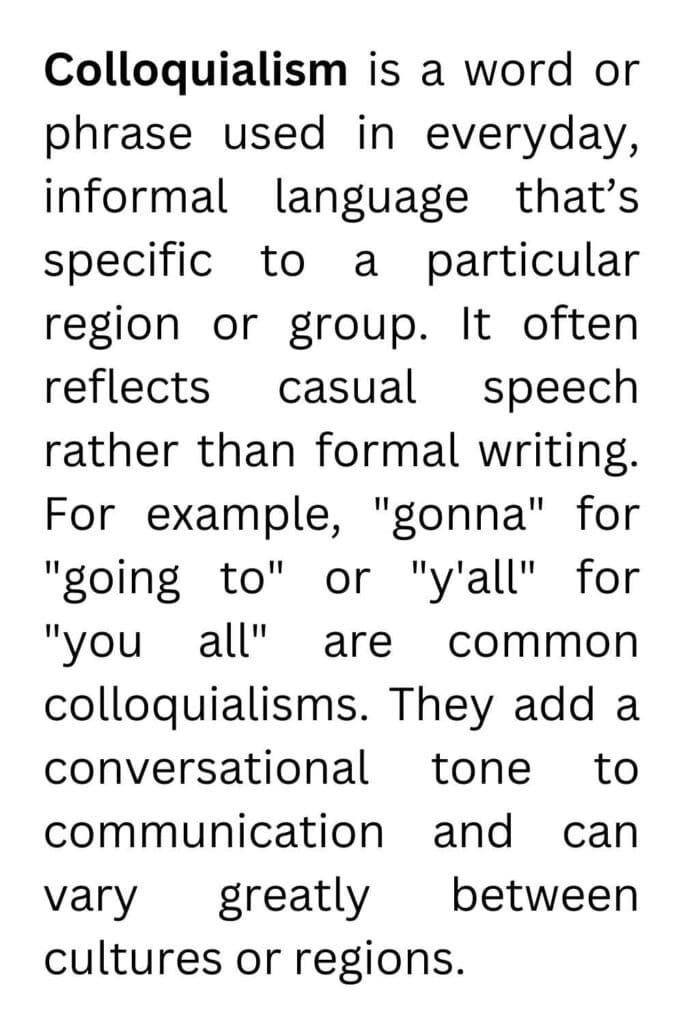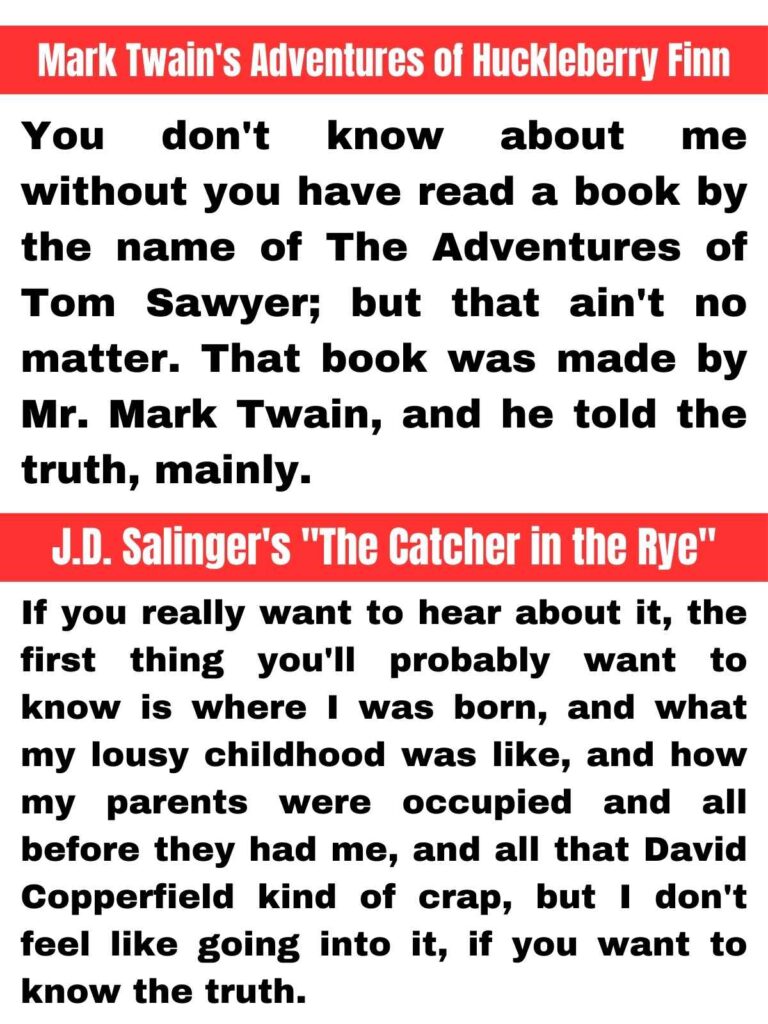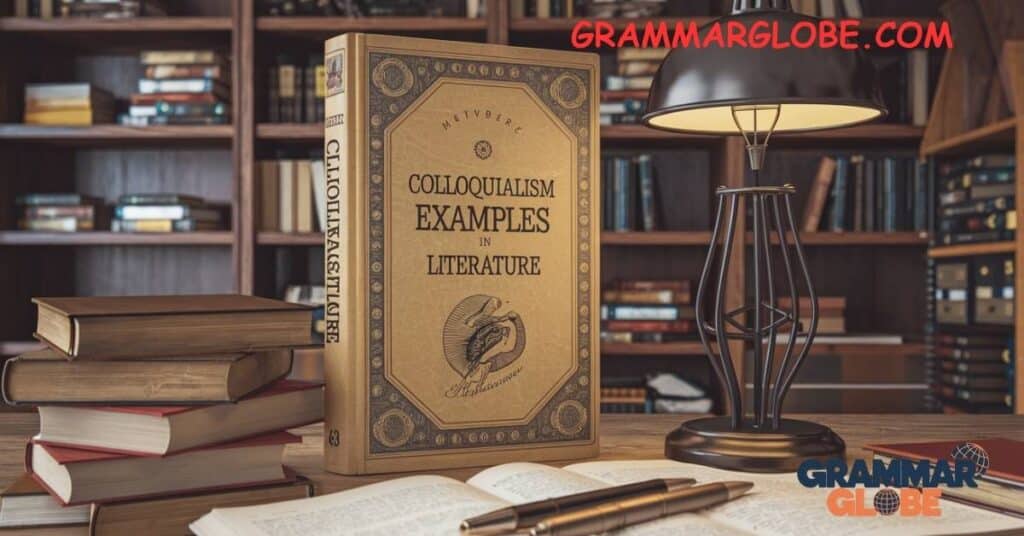In the grand tapestry of literature, colloquialism stands out as a vibrant thread, weaving authenticity and relatability into the fabric of storytelling. These everyday expressions and informal language choices breathe life into characters, paint vivid settings, and forge intimate connections between readers and the written word. Let’s embark on a journey through the world of colloquialism examples in literature, exploring how authors harness the power of casual speech to craft unforgettable narratives.
What is Colloquialism
Colloquialism is a word or phrase used in everyday, informal language that’s specific to a particular region or group. It often reflects casual speech rather than formal writing. For example, “gonna” for “going to” or “y’all” for “you all” are common colloquialisms. They add a conversational tone to communication and can vary greatly between cultures or regions.

You May Like: End Rhyme Examples in Poetry
Unpacking Colloquialism: The Voice of the Streets
Before we dive into specific colloquialism examples in literature, it’s crucial to grasp the essence of this linguistic phenomenon. A colloquialism is a word, phrase, or expression characteristic of ordinary or familiar conversation rather than formal speech or writing. It’s the language you’d hear at a bustling street market, a lively family dinner, or a casual chat with friends – not in a courtroom or academic lecture.
Colloquialisms come in various flavors:
- Regionalisms: Expressions tied to specific geographic areas
- Idioms: Phrases whose meanings transcend their literal words
- Slang: Informal language often associated with particular groups or subcultures
- Shortened forms: Contractions and abbreviations that pepper everyday speech
- Jargon: Specialized language that, while not strictly colloquial, can function similarly in literature
To illustrate the stark contrast between formal and colloquial language, consider this comparison:
| Formal | Colloquial |
|---|---|
| I am not inclined to participate | I’m not up for it |
| That is incorrect | You’re way off base |
| I am experiencing fatigue | I’m totally wiped out |
| Please provide your opinion | What’s your take on this? |
| That is an excessive amount | That’s way too much |
You May Like: What is Imagery and Its Types? | Examples of Imagery in Poetry
The Colloquial Spectrum: From Subtle to Striking
Colloquialism examples in literature span a wide range, from mild deviations from standard English to wild dialectical variations that can challenge even native speakers. Let’s break it down:
- Mild colloquialisms: These subtle departures from formal language include contractions (it’s, don’t, I’m) and common idioms (“break a leg,” “under the weather”).
- Regionalisms and dialects: These often provide the most colorful and challenging forms of colloquialism. Think of the rich Southern drawl in Zora Neale Hurston’s work or the Cockney rhyming slang in British literature.
- Slang: Ever-evolving and often generational, slang keeps dialogue fresh and contemporary. J.D. Salinger’s use of 1950s teen slang in “The Catcher in the Rye” is a prime example.
- Professions jargon: While technically not colloquial, profession-specific jargon can function similarly in literature, adding authenticity to character voices and settings.
Why Writers Wield the Colloquial Pen
Authors employ colloquialism examples in literature for various compelling reasons:
- Creating believable characters: Colloquial speech patterns can instantly make a character feel real and relatable. A character’s use of “ain’t” or “y’all” immediately paints a picture of their background and personality.
- Establishing setting: Regional colloquialisms can quickly transport the reader to a specific time and place. The use of “wicked” as an intensifier immediately suggests a New England setting, for instance.
- Breaking down barriers: Informal language can make complex ideas more accessible and engaging. It’s often easier to explain a difficult concept using everyday language than formal terminology.
- Injecting humor: Many colloquialisms carry inherent humor or wit. Think of colorful expressions like “madder than a wet hen” or “not the sharpest tool in the shed.”
- Conveying emotion: Colloquial expressions often pack an emotional punch that more formal language lacks. “I’m over the moon” conveys joy more vividly than “I’m very happy.”
“The difference between the almost right word and the right word is really a large matter—it’s the difference between the lightning bug and the lightning.” – Mark Twain
This quote from Twain, a master of colloquial writing, underscores the power of precise language choice – including colloquialisms – in literature.
Colloquialism Through the Ages: A Literary Time Machine
The use of colloquialism examples in literature has evolved dramatically over time:
- Shakespeare’s era: Believe it or not, the Bard was one of the first to popularize colloquial language in literature, often inventing new words and phrases that we still use today. “It’s Greek to me” and “wild goose chase” are just a couple of examples.
- 18th and 19th centuries: The rise of the novel saw increased use of vernacular to create realistic characters. Authors like Charles Dickens and Mark Twain were pioneers in this regard, using dialect and colloquialisms to bring their characters to life.
- Modernist era: Writers like James Joyce and Virginia Woolf pushed the boundaries of language, incorporating diverse dialects and speech patterns into their work. Joyce’s “Ulysses” is famous for its use of Dublin colloquialisms.
- Post-war period: The Beat Generation writers like Jack Kerouac embraced the rhythms and vocabulary of jazz and street speech, further expanding the use of colloquialism in literature.
- Contemporary literature: Today’s authors often blend multiple linguistic influences, reflecting our globalized world. Writers like Junot Díaz seamlessly incorporate Spanish colloquialisms into English text, creating a unique literary voice.

Diving into the Colloquial Pool: Examples from the Greats
Let’s explore some stellar colloquialism examples in literature from renowned authors:
Mark Twain’s “Adventures of Huckleberry Finn”
Twain’s use of dialect in this classic novel is legendary. Here’s a sample:
“You don’t know about me without you have read a book by the name of The Adventures of Tom Sawyer; but that ain’t no matter. That book was made by Mr. Mark Twain, and he told the truth, mainly.”
This opening passage immediately establishes Huck’s voice, using contractions (“don’t”), double negatives (“ain’t no”), and non-standard grammar (“without you have read”) to create an authentic, uneducated Southern voice.
Zora Neale Hurston’s “Their Eyes Were Watching God”
Hurston masterfully captures African American Vernacular English:
“Ah ain’t never seen mah papa. And Ah didn’t know ‘im if Ah did. Mah mama neither. She was gone from round dere long before Ah wuz big enough tuh know. Mah grandma raised me.”
This passage showcases Hurston’s skill in phonetically rendering dialect, with “Ah” for “I,” “‘im” for “him,” and the use of “tuh” for “to.” The rhythm and structure of the sentences also mirror spoken language.
J.D. Salinger’s “The Catcher in the Rye”
Salinger’s Holden Caulfield speaks in the quintessential voice of a 1950s teenager:
“If you really want to hear about it, the first thing you’ll probably want to know is where I was born, and what my lousy childhood was like, and how my parents were occupied and all before they had me, and all that David Copperfield kind of crap, but I don’t feel like going into it, if you want to know the truth.”
The casual “and all,” the dismissive “crap,” and the repetitive structure mirror teenage speech patterns perfectly. The use of “lousy” and the direct address to the reader create an immediate sense of Holden’s personality.
Irvine Welsh’s “Trainspotting”
Welsh takes colloquialism to the extreme with his phonetic rendering of Scottish dialect:
“The sweat wis lashing oafay Sick Boy; he wis trembling. Ah wis jist sitting thair, focusing oan the telly, tryin no tae notice the cunt. He wis bringing me doon. Ah tried tae keep ma attention oan the Jean-Claude Van Damme video.”
This passage requires careful reading but powerfully conveys the characters’ backgrounds and the gritty setting of the novel. Welsh’s use of phonetic spelling (“wis” for “was,” “oan” for “on”) and Scottish slang (“cunt” used casually) creates an immersive experience.
Junot Díaz’s “The Brief Wondrous Life of Oscar Wao”
Díaz blends English, Spanish, and slang to create a unique voice:
“Dude was a marginal student at best, a hilariously bad dancer, and couldn’t run to save his life. Couldn’t play sports for shit, or dominoes, was always losing his lunch money to some punk, and was scared of dogs.”
The casual “Dude,” the use of “shit” as an intensifier, and the phrase “lunch money” all contribute to the colloquial tone. Díaz often incorporates untranslated Spanish words and phrases elsewhere in the novel, adding another layer of linguistic richness.

The Fine Line: When Colloquialism Works (and When It Doesn’t)
While colloquialism examples in literature can be incredibly effective, they require a delicate balance:
- Authenticity vs. Readability: Too much dialect can become exhausting for readers. It’s important to strike a balance between authenticity and clarity.
- Avoiding Stereotypes: Colloquialisms should add depth to characters, not reduce them to caricatures. It’s crucial to use dialect and slang respectfully and accurately.
- Staying Current: Slang can quickly become dated, potentially alienating future readers. Using too many trendy expressions can make a work feel obsolete quickly.
- Consistency: Once an author establishes a character’s way of speaking, it’s important to maintain that voice consistently throughout the work.
Colloquialisms in the Digital Age
The internet and social media have revolutionized colloquial language, introducing new forms of expression:
- Abbreviations: LOL, TBH, FOMO are now commonly understood and used in everyday speech.
- Emojis: These pictographs often stand in for words or entire phrases, adding nuance to digital communication.
- Memes: These viral images or phrases quickly enter the colloquial lexicon, often carrying complex cultural references.
- Hashtags: Originally a categorization tool, hashtags have evolved into a form of commentary or punchline.
Authors like Jennifer Egan have experimented with incorporating these new forms of colloquialism into literature. Her Twitter-story “Black Box” is a prime example of adapting literary style to the constraints and conventions of social media.
Crafting Your Own Colloquial Voice
For aspiring writers looking to incorporate colloquialism examples in literature, here are some tips:
- Listen actively: Pay attention to how people really speak in different contexts. Eavesdrop (politely) in coffee shops, on public transport, or at social gatherings.
- Read widely: Expose yourself to various authors’ uses of colloquial language. Pay attention to how they balance authenticity with readability.
- Start small: Begin with mild colloquialisms before attempting heavy dialect. Contractions, common idioms, and slight grammatical irregularities can add flavor without overwhelming the reader.
- Read aloud: This can help you catch unnatural-sounding phrases. If it feels awkward to say, it will probably feel awkward to read.
- Get feedback: Have others read your dialogue to ensure it sounds authentic. If possible, get input from people familiar with the dialect or slang you’re trying to capture.
- Research thoroughly: If you’re writing about a time or place you’re not familiar with, do your homework. Historical documents, oral histories, and dialect dictionaries can be invaluable resources.
- Use colloquialisms purposefully: Every instance of non-standard language should serve a purpose, whether it’s characterization, setting, or tone.
Case Study: The Evolution of Colloquialism in Steinbeck’s Work
John Steinbeck’s use of colloquialism evolved throughout his career, reflecting changing attitudes toward vernacular in literature:
- Early work (“Tortilla Flat”): Heavy use of dialect, sometimes criticized as stereotypical. Steinbeck attempted to capture the speech patterns of the paisanos of Monterey, California. Example: “Ai, little angelic one,” Pablo would say. “Littlest one, there is no Cornelia here. Thy father is mistaken again.”
- Mid-career (“The Grapes of Wrath”): More subtle use of colloquialism, focusing on rhythm and selective word choice rather than phonetic spelling. Example: “I ain’t gonna hurt ya. Jus’ thought I’d like to talk to somebody.”
- Late career (“East of Eden”): Refined balance between standard English and colloquial expressions, using colloquialisms primarily for character differentiation and emotional emphasis. Example: “You’re damn right I’m going to talk about it! I’m going to yell about it! You’re not going to get rid of it that way.”
This progression shows how authors can refine their use of colloquialism over time, finding the sweet spot between authenticity and readability.

The Global Impact of Colloquialism in Literature
The use of colloquialism examples in literature has had a profound impact on global literature and language:
- Preserving Dialects: Literary works often serve as records of regional dialects and expressions that might otherwise be lost to time.
- Cultural Exchange: Books featuring colloquial language from one culture can introduce readers from other cultures to new ways of expression.
- Challenging Language Norms: The incorporation of non-standard English in literature has played a role in questioning and expanding what is considered “proper” language.
- Influencing Spoken Language: Colloquialisms popularized in literature sometimes make their way into everyday speech. Shakespeare, for instance, is credited with introducing many phrases we still use today.
Conclusion: The Enduring Appeal of the Everyday in Literature
Colloquialism examples in literature serve as a powerful reminder of language’s ability to connect us. By bringing the cadences of everyday speech into their work, authors bridge the gap between the written word and the spoken, creating stories that resonate on a deeply human level.
As our world becomes increasingly interconnected, the role of colloquialism in literature is likely to evolve further. We may see more blending of regional expressions, a greater influence of digital communication patterns, and perhaps entirely new forms of colloquialism emerging.
One thing is certain: as long as there are stories to tell, there will be authors finding fresh, authentic ways to tell them – and colloquialism will remain a vital tool in their literary arsenal. Whether it’s Huck Finn’s rural drawl, Holden Caulfield’s teenage angst, or the multilingual tapestry of contemporary immigrant narratives, colloquial language will continue to bring literature to life, one familiar phrase at a time.
In the end, colloquialism examples in literature remind us that great stories aren’t just about grand ideas or beautiful prose – they’re about capturing the rhythms and realities of human experience. And what better way to do that than through the words we use every day?

Oliver Smith is an experienced blogger at Grammar Globe, Oliver Smith, an expert in English grammar and a master of wit, brings language to life with his playful take on puns. Through his works, he weaves humor into the rules of grammar, making learning fun and engaging for readers of all ages. Discover language with a smile!”






